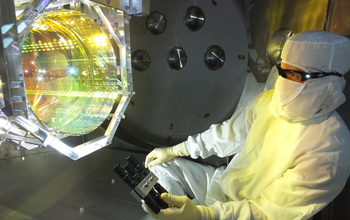Multimedia Gallery
LIGO opens new window on the universe (Image 3)
Prior to sealing up the chamber and pumping the vacuum system down, a Laser Interferometer Gravitational-wave Observatory (LIGO) optics technician inspects one of LIGO’s core optics (mirrors) by illuminating its surface with light at a glancing angle. It is critical to LIGO's operation that there is no contamination on any of its optical surfaces.
More about this image
On Sept. 14, 2015, at 5:51 a.m. EDT (09:51 UTC), for the first time, scientists observed ripples in the fabric of spacetime, called gravitational waves, arriving at Earth from a cataclysmic event in the distant universe. This confirmed a major prediction of Albert Einstein's 1915 general theory of relativity and opens an unprecedented new window to the cosmos.
The gravitational waves were detected by both of the twin Laser Interferometer Gravitational-wave Observatory (LIGO) detectors, located in Livingston, Louisiana, and Hanford, Washington. The LIGO observatories are funded by the National Science Foundation (NSF), and were conceived, built and are operated by the California Institute of Technology (Caltech) and the Massachusetts Institute of Technology (MIT).
Gravitational waves carry information about their dramatic origins and about the nature of gravity that cannot be obtained from elsewhere. Physicists have concluded that the detected gravitational waves were produced during the final fraction of a second of the merger of two black holes to produce a single, more massive spinning black hole. This collision of two black holes had been predicted but never observed.
Based on the observed signals, LIGO scientists estimate that the black holes for this event were about 29 and 36 times the mass of the sun, and the event took place 1.3 billion years ago. About three times the mass of the sun was converted into gravitational waves in a fraction of a second, with a peak power output about 50 times that of the whole visible universe. By looking at the time of arrival of the signals -- the detector in Livingston recorded the event 7 milliseconds before the detector in Hanford -- scientists can say that the source was located in the Southern Hemisphere.
The new LIGO discovery is the first observation of gravitational waves themselves, made by measuring the tiny disturbances the waves make to space and time as they pass through the Earth.
To learn more about this exciting discovery, see NSF press release 16-015, Gravitational waves detected 100 years after Einstein's prediction. To learn more about LIGO, see the NSF Special Report LIGO #Einstein was right. (Date image taken: December 14, 2015; date originally posted to NSF Multimedia Gallery: March 17, 2016) [Image 3 of 15 related images. See Image 4.]
Credit: Matt Heintze/Caltech/MIT/LIGO Lab
See other images like this on your iPhone or iPad download NSF Science Zone on the Apple App Store.
Images and other media in the National Science Foundation Multimedia Gallery are available for use in print and electronic material by NSF employees, members of the media, university staff, teachers and the general public. All media in the gallery are intended for personal, educational and nonprofit/non-commercial use only.
Images credited to the National Science Foundation, a federal agency, are in the public domain. The images were created by employees of the United States Government as part of their official duties or prepared by contractors as "works for hire" for NSF. You may freely use NSF-credited images and, at your discretion, credit NSF with a "Courtesy: National Science Foundation" notation.
Additional information about general usage can be found in Conditions.
Also Available:
Download the high-resolution JPG version of the image. (4.1 MB)
Use your mouse to right-click (Mac users may need to Ctrl-click) the link above and choose the option that will save the file or target to your computer.

